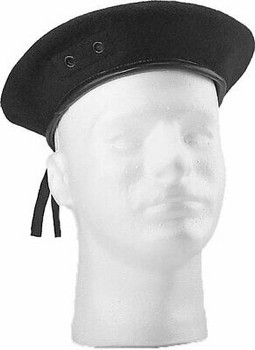Description
Military Army Wool Beret with Eyelets, No Flash
* Made From 95% Wool & 5% Nylon Material
* No Flash Included
* Pre-Shaven
* Built In Clutch
* Eyelets (2 Holes On Top)
* Vinyl Headband Inside
* Vinyl leather-like Trim All Around
* Drawstring To Adjust Beret To Perfect Size
* Unisex
* Perfect Attire To Go With Your Uniform
* Soft & Light Material
Options:
* Maroon (4909)
* Green (4908)
* Black (4907)
* Navy Blue (4916)
* Red (4901)
About Berets and its use in the U.S. Armed Forces and Military Branches
Berets were originally worn by select forces in the United States Army. The first were worn during World War II, when a battalion of the 509th Parachute Infantry Regiment were presented maroon berets by their British counterparts. Though unofficial at first, the green beret of the US Army Special Forces was formally adopted in 1961. Maroon airborne and black US Army Ranger berets were formally authorized in the 1970s.
"D" Troop 17th Cavalry were authorized a maroon beret in Vietnam.
After the Vietnam War, morale in the US Army waned. In response, from 1973 through 1979 HQDA permitted local commanders to encourage morale-enhancing uniform distinctions, however these distinctions were only allowed to be worn on the post. Consequently, many units embraced various colored berets, for example Armor and Armored Cavalry units often adopted the black beret. Similarly many other units embraced various colored berets in an attempt to improve dwindling morale. In particular, the First Cavalry Division assigned various colored berets to its three pronged TRICAP approach. In this implementation, Armored Cavalry, Airmobile Infantry units, Air Cavalry units, Division Artillery units, and Division Support units all wore different colored berets, including black, light blue, kelly green, and red. The 101st Airborne Division was authorised a dark blue beret.
In 1975 all female soldiers of the Women's Army Corps were authorized to wear a black beret variant as standard headgear for the service uniform.
In 1975 the 172nd light Infantry Brg. out of Ft. Richarderson, Alaska was wearing the Olive Drab Berets.
In 2001, Army Chief of Staff Eric Shinseki ordered the black beret worn as standard headgear army-wide, a controversial decision because it was previously reserved for the Rangers. The Rangers were then authorized to wear a tan beret, exclusive to them. The decision was implemented in hopes of boosting morale among conventional units. However, many soldiers began complaining that the new black beret was not practical with the utility uniform. In June 2011, Army Secretary John McHugh, acting on the recommendations made by Chief of Staff Martin Dempsey and Sergeant Major of the Army Raymond F. Chandler, once again chose the traditional patrol cap to be worn with the utility uniform. The black beret may be authorized with utility uniforms at commander's discretion for special ceremonies. The beret remains part of the Army's dress uniform for all units.
United States Army berets now use the following distinctive colors:
US Army
Color / Wearer
Rifle green - Special Forces qualified soldiers assigned to U.S. Army Special Operations Command (USASOC) units
Tan - Soldiers assigned to the 75th Ranger Regiment and Ranger Training Brigade
Maroon - Soldiers assigned to the 82nd Airborne Division, 173rd Airborne Brigade Combat Team, 4th Brigade Combat Team (Airborne), and non-SF qualified soldier attached to USASOC units
Khaki - Soldiers assigned to one of the Security Force Assistance Brigades
Black - Worn by all soldiers with Army Service Uniform as standard headgear. The patrol cap is the standard headgear with utility uniforms such as the ACUs; however, the black beret may be authorized with utility uniforms at commander's discretion.
Special Forces, Ranger, and Airborne unit berets sport distinctive organizational flashes. All other units use a standard pale blue flash bordered with 13 white stars. Officers wear their rank insignia within the flash, while enlisted ranks wear their distinctive unit insignia.
US Air Force
Color / Wearer
Black - Tactical Air Control Party (TACP), Air Liaison Officers (ALO), and Air Mobility Liaison Officers (AMLO)
Maroon - Combat Rescue Officers, Pararescuemen
Scarlet - Special Tactics Officers, Combat Controllers
Pewter Grey - Special Operations Weather Technician
Dark Blue - Security Forces
Sage Green - Survival, Evasion, Resistance and Escape (SERE) Specialists
In the United States Navy, female officers and sailors were allowed to wear black berets instead of a combination hat or garrison cap while in service uniforms until 2016. The black berets were phased out in October of that year due to a lack of widespread use and a desire by the U.S. Navy to make its uniforms more unisex in appearance. During the Vietnam War, the U.S. Navy created special boat teams, unofficially dubbed the brown-water navy, to patrol coastlines, estuaries and rivers. Naval personnel assigned to these teams wore black berets as part of their uniform, as portrayed in the movie Apocalypse Now. U.S. Navy SEAL teams serving in Vietnam wore camouflage berets in the field, the only beret somewhat standardized in the SEALs.
Military Berets
Berets have been a component of the uniforms of many armed forces throughout the world since the mid-20th century. Military berets are usually pushed to the right to free the shoulder that bears the rifle on most soldiers, but the armies of some countries, mostly within Europe, South America and Asia have influenced the push to the left.
In some countries, berets are associated with elite units, who often wear berets in more unusual colors. For instance. the maroon beret is mostly traditional headgear for elite airborne forces around the world with a few exceptions like the elite Russian Airborne Troops who instead wear a sky blue beret.






